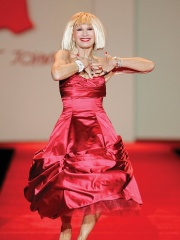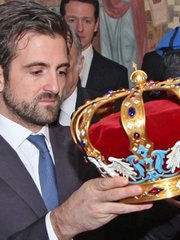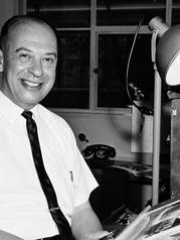
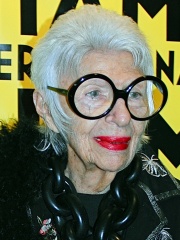
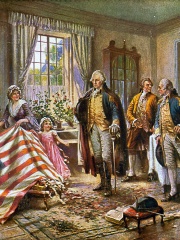

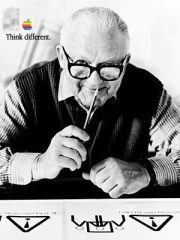
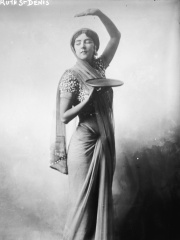
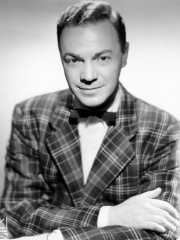
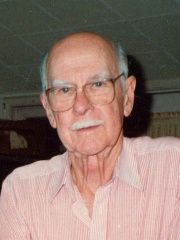
The Most Famous
DESIGNERS from United States
This page contains a list of the greatest American Designers. The pantheon dataset contains 104 Designers, 20 of which were born in United States. This makes United States the birth place of the 2nd most number of Designers.
Top 10
The following people are considered by Pantheon to be the top 10 most legendary American Designers of all time. This list of famous American Designers is sorted by HPI (Historical Popularity Index), a metric that aggregates information on a biography's online popularity. Visit the rankings page to view the entire list of American Designers.

1. Steve Jobs (1955 - 2011)
With an HPI of 88.84, Steve Jobs is the most famous American Designer. His biography has been translated into 168 different languages on wikipedia.
Steven Paul Jobs (February 24, 1955 – October 5, 2011) was an American businessman, inventor, and investor best known for co-founding the technology company Apple Inc. Jobs was also the founder of NeXT and chairman and majority shareholder of Pixar. He was a pioneer of the personal computer revolution of the 1970s and 1980s, along with his early business partner and fellow Apple co-founder Steve Wozniak. Jobs was born in San Francisco in 1955 and adopted shortly afterwards. He attended Reed College in 1972 before withdrawing that same year. In 1974, he traveled through India, seeking enlightenment before later studying Zen Buddhism. He and Wozniak co-founded Apple in 1976 to further develop and sell Wozniak's Apple I personal computer. Together, the duo gained fame and wealth a year later with production and sale of the Apple II, one of the first highly successful mass-produced microcomputers. Jobs saw the commercial potential of the Xerox Alto in 1979, which was mouse-driven and had a graphical user interface (GUI). This led to the development of the largely unsuccessful Apple Lisa in 1983, followed by the breakthrough Macintosh in 1984, the first mass-produced computer with a GUI. The Macintosh launched the desktop publishing industry in 1985 (for example, the Aldus PageMaker) with the addition of the Apple LaserWriter, the first laser printer to feature vector graphics and PostScript. In 1985, Jobs departed Apple after a long power struggle with the company's board and its then-CEO, John Sculley. That same year, Jobs took some Apple employees with him to found NeXT, a computer platform development company that specialized in computers for higher-education and business markets, serving as its CEO. In 1986, he bought the computer graphics division of Lucasfilm, which was spun off independently as Pixar. Pixar produced the first computer-animated feature film, Toy Story (1995), and became a leading animation studio, producing dozens of commercially successful and critically acclaimed films. In 1997, Jobs returned to Apple as CEO after the company's acquisition of NeXT. He was largely responsible for reviving Apple, which was on the verge of bankruptcy. He worked closely with British designer Jony Ive to develop a line of products and services that had larger cultural ramifications, beginning with the "Think different" advertising campaign, and leading to the iMac, iTunes, Mac OS X, Apple Store, iPod, iTunes Store, iPhone, App Store, and iPad. Jobs was also a board member at Gap Inc. from 1999 to 2002. In 2003, Jobs was diagnosed with a pancreatic neuroendocrine tumor. He died of tumor-related respiratory arrest in 2011; in 2022, he was posthumously awarded the Presidential Medal of Freedom. Since his death, he has won 141 patents; Jobs holds over 450 patents in total.

2. Iris Apfel (1921 - 2024)
With an HPI of 66.77, Iris Apfel is the 2nd most famous American Designer. Her biography has been translated into 35 different languages.
Iris Apfel ( AP-fəl; née Barrel; August 29, 1921 – March 1, 2024) was an American businesswoman, interior designer, and fashion designer, known for her flamboyant style, outspoken personality and oversized eyeglasses. In business with her husband, Carl, from 1950 to 1992, Apfel had a career in textiles, including a contract with the White House that spanned nine presidencies. In retirement, she drew acclaim for a 2005 show at the Costume Institute at The Metropolitan Museum of Art featuring her collection of costume jewelry and styled with clothes on mannequins as she would wear them. She became a fashion icon, was the focus of the 2014 Albert Maysles documentary Iris, then signed to IMG in 2019 as a model at age 97.

3. Betsy Ross (1752 - 1836)
With an HPI of 60.49, Betsy Ross is the 3rd most famous American Designer. Her biography has been translated into 28 different languages.
Elizabeth Griscom Ross (née Griscom; January 1, 1752 – January 30, 1836), also known by her second and third married names, Ashburn and Claypoole, was an American upholsterer who was credited by her relatives in 1870 with designing and making the first U.S. flag, commonly known as the Betsy Ross flag. Though historians dismissed the story both then and now, Ross family tradition holds that General George Washington, commander-in-chief of the Continental Army and two members of a congressional committee—Robert Morris and George Ross—visited Ross in 1776. Ross convinced Washington to change the shape of the stars in a sketch of a flag he showed her from six-pointed to five-pointed by demonstrating that it was easier and speedier to cut the latter. However, there is no archival evidence or other recorded verbal tradition to substantiate this story of the first U.S. flag. It appears that the story first surfaced in the writings of her grandson in the 1870s (a century after the fact), with no mention or documentation in earlier decades. The myth was later incorporated into a large oil painting that appeared at the 1893 Chicago World's fair. The painter, Charles Weisgerber, subsequently promoted the myth, even buying a house he deemed The Betsy Ross House. He solicited money nationwide for the upkeep of the house as a tourist attraction. With the solicitations, he provided a synopsis of the myth with reproductions of his painting. Ross made flags for the Pennsylvania Navy during the American Revolution. After the Revolution, she made U.S. flags for over 50 years, including 50 garrison flags for the U.S. Arsenal on the Schuylkill River during 1811. The flags of the Pennsylvania navy were overseen by the Pennsylvania Navy Board. The board reported to the Pennsylvania Provincial Assembly's Committee of Safety. In July 1775, the President of the Committee of Safety was Benjamin Franklin. Its members included Robert Morris and George Ross. At that time, the committee ordered the construction of gunboats that would eventually need flags as part of their equipment. As late as October 1776, Captain William Richards was still writing to the Committee of Safety to request the design that he could use to order flags for the fleet. Ross was one of those hired to make flags for the Pennsylvanian fleet. An entry dated May 29, 1777, in the records of the Pennsylvania Navy Board, includes an order to pay her for her work. It is worded as follows: The Pennsylvania navy's ship colors included an ensign, a long, narrow pennant, and a short, narrow pennant. The ensign was a blue flag with 13 stripes—seven red stripes and six white stripes in the flag's canton (upper-left-hand corner). It was flown from a pole at the rear of the ship. The long pennant had 13 vertical, red-and-white stripes near the mast; the rest was solid red. It flew from the top of the ship's mainmast, the center pole holding the sails. The short pennant was solid red, and flew from the top of the ship's mizzenmast—the pole holding the ship's sails nearest the stern (rear of the ship).

4. Milton Glaser (1929 - 2020)
With an HPI of 59.95, Milton Glaser is the 4th most famous American Designer. His biography has been translated into 26 different languages.
Milton Glaser (June 26, 1929 – June 26, 2020) was an American graphic designer whose most recognized works include the I ❤ NY logo, the 1966 Bob Dylan poster, as well as late 1960s publicity posters for the introduction of the Olivetti Valentine typewriter, and logos for DC Comics, Stony Brook University, Brooklyn Brewery, among others. In 1954, he co-founded Push Pin Studios, co-founded New York magazine with Clay Felker, and established Milton Glaser, Inc. In 1969, he produced and designed "Short Subject", commonly known as "Mickey Mouse in Vietnam", a short 16mm anti-war film directed by Whitney Lee Savage (father of Adam Savage). His artwork has been featured in exhibits, and placed in permanent collections in many museums worldwide. During his long career he designed many posters, publications and architectural designs. He received many awards for his work, including the National Medal of the Arts award from President Barack Obama in 2009, the first time a graphic designer received this award.

5. Syd Mead (1933 - 2019)
With an HPI of 59.77, Syd Mead is the 5th most famous American Designer. His biography has been translated into 22 different languages.
Sydney Jay Mead (July 18, 1933 – December 30, 2019) was an American industrial designer and neo-futurist concept artist. Initially known for his influential futuristic design work for industrial clients such as U.S. Steel, Philips, and Ford, he subsequently went on to create conceptual and world designs for science-fiction films such as Blade Runner, Aliens and Tron. Mead has been described as "the artist who illustrates the future" and "one of the most influential concept artists and industrial designers of our time."

6. Paul Rand (1914 - 1996)
With an HPI of 58.28, Paul Rand is the 6th most famous American Designer. His biography has been translated into 29 different languages.
Paul Rand (born Peretz Rosenbaum; August 15, 1914 – November 26, 1996) was an American art director and graphic designer. He is known for his corporate logo designs, including the logos for IBM, UPS, Enron, Morningstar, Inc., Westinghouse, ABC, and NeXT. He developed an American Modernistic style from European influences and was one of the first American commercial artists to embrace and practice the Swiss Style of graphic design. Rand was a professor emeritus of graphic design at Yale University in New Haven, Connecticut, where he taught from 1956 to 1969, and from 1974 to 1985. He was inducted into the New York Art Directors Club Hall of Fame in 1972.

7. Ruth St. Denis (1879 - 1968)
With an HPI of 55.93, Ruth St. Denis is the 7th most famous American Designer. Her biography has been translated into 19 different languages.
Ruth St. Denis (born Ruth Dennis; January 20, 1879 – July 21, 1968) was an American pioneer of modern dance, introducing eastern ideas into the art and paving the way for other women in dance. She was inspired by the Delsarte advocate Genevieve Stebbins. St. Denis was the co-founder in 1915 of the American Denishawn School of Dancing and Related Arts. She taught notable performers including Martha Graham and Doris Humphrey. In 1938, she founded the pioneering dance program at Adelphi University. She published several articles on spiritual dance and the mysticism of the body. Her signature solos continue to be performed. She was inducted into the National Museum of Dance and Hall of Fame in 1987.

8. Alan Freed (1921 - 1965)
With an HPI of 55.74, Alan Freed is the 8th most famous American Designer. His biography has been translated into 24 different languages.
Albert James "Alan" Freed (December 15, 1921 – January 20, 1965) was an American disc jockey. He also produced and promoted large traveling concerts with various acts, helping to spread the importance of rock and roll music throughout North America, including popularizing the term "rock and roll". In 1986, Freed was inducted into the Rock and Roll Hall of Fame. His "role in breaking down racial barriers in U.S. pop culture in the 1950s, by leading white and black kids to listen to the same music, put the radio personality 'at the vanguard' and made him 'a really important figure'", according to the executive director.

9. Ollie Johnston (1912 - 2008)
With an HPI of 55.37, Ollie Johnston is the 9th most famous American Designer. His biography has been translated into 22 different languages.
Oliver Martin Johnston Jr. (October 31, 1912 – April 14, 2008) was an American motion picture animator. He was one of Disney's Nine Old Men, and the last surviving at the time of his death from natural causes. He was recognized by The Walt Disney Company with its Disney Legend Award in 1989. His work was recognized with the National Medal of Arts in 2005.
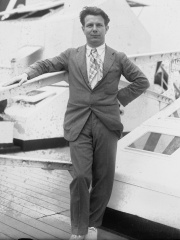
10. Norman Bel Geddes (1893 - 1958)
With an HPI of 53.92, Norman Bel Geddes is the 10th most famous American Designer. His biography has been translated into 19 different languages.
Norman Bel Geddes (born Norman Melancton Geddes; April 27, 1893 – May 8, 1958) was an American theatrical and industrial designer, described in 2012 by the New York Times as "a brilliant craftsman and draftsman, a master of style, the 20th century’s Leonardo da Vinci." As a young designer, Bel Geddes brought an innovative and energized perspective to the Broadway stage and New York’s Metropolitan Opera. In the 1930s he became one of the first to hold the title of Industrial Designer. His futuristic Streamline designs re-envisioned many of the utilitarian objects of the day from airplanes and ocean liners to cocktail shakers and circuses. He also conceived and oversaw construction of the Futurama Exhibition at the 1939 New York World's Fair.
People
Pantheon has 20 people classified as American designers born between 1752 and 1980. Of these 20, 7 (35.00%) of them are still alive today. The most famous living American designers include Colleen Atwood, Betsey Johnson, and Robert Stromberg. The most famous deceased American designers include Steve Jobs, Iris Apfel, and Betsy Ross. As of April 2024, 3 new American designers have been added to Pantheon including Robert Stromberg, Prince Peter of Yugoslavia, and Ruth E. Carter.
Living American Designers
Go to all RankingsColleen Atwood
1948 - Present
HPI: 53.88
Betsey Johnson
1942 - Present
HPI: 49.55
Robert Stromberg
HPI: 47.03
Prince Peter of Yugoslavia
1980 - Present
HPI: 43.86
Ruth E. Carter
1960 - Present
HPI: 41.88
Cliff Bleszinski
1975 - Present
HPI: 39.36
Hank Green
1980 - Present
HPI: 37.08
Deceased American Designers
Go to all RankingsSteve Jobs
1955 - 2011
HPI: 88.84
Iris Apfel
1921 - 2024
HPI: 66.77
Betsy Ross
1752 - 1836
HPI: 60.49
Milton Glaser
1929 - 2020
HPI: 59.95
Syd Mead
1933 - 2019
HPI: 59.77
Paul Rand
1914 - 1996
HPI: 58.28
Ruth St. Denis
1879 - 1968
HPI: 55.93
Alan Freed
1921 - 1965
HPI: 55.74
Ollie Johnston
1912 - 2008
HPI: 55.37
Norman Bel Geddes
1893 - 1958
HPI: 53.92
Marc Davis
1913 - 2000
HPI: 53.76
Virgil Abloh
1980 - 2021
HPI: 52.02
Newly Added American Designers (2025)
Go to all RankingsRobert Stromberg
HPI: 47.03
Prince Peter of Yugoslavia
1980 - Present
HPI: 43.86
Ruth E. Carter
1960 - Present
HPI: 41.88
Overlapping Lives
Which Designers were alive at the same time? This visualization shows the lifespans of the 13 most globally memorable Designers since 1700.


